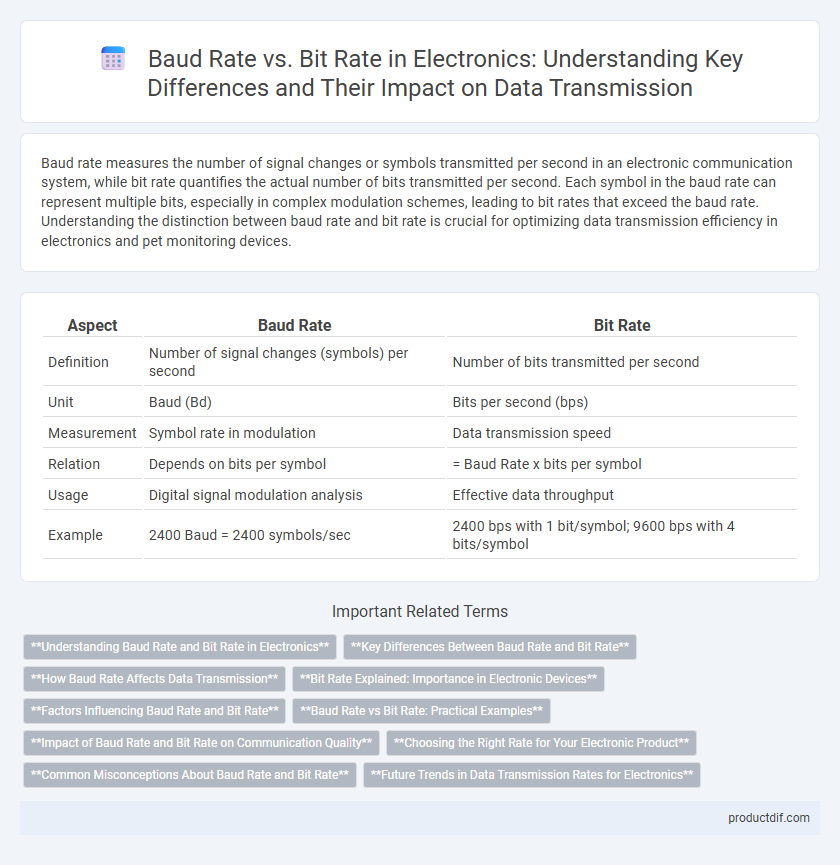Baud rate measures the number of signal changes or symbols transmitted per second in an electronic communication system, while bit rate quantifies the actual number of bits transmitted per second. Each symbol in the baud rate can represent multiple bits, especially in complex modulation schemes, leading to bit rates that exceed the baud rate. Understanding the distinction between baud rate and bit rate is crucial for optimizing data transmission efficiency in electronics and pet monitoring devices.
Table of Comparison
| Aspect | Baud Rate | Bit Rate |
|---|---|---|
| Definition | Number of signal changes (symbols) per second | Number of bits transmitted per second |
| Unit | Baud (Bd) | Bits per second (bps) |
| Measurement | Symbol rate in modulation | Data transmission speed |
| Relation | Depends on bits per symbol | = Baud Rate x bits per symbol |
| Usage | Digital signal modulation analysis | Effective data throughput |
| Example | 2400 Baud = 2400 symbols/sec | 2400 bps with 1 bit/symbol; 9600 bps with 4 bits/symbol |
Understanding Baud Rate and Bit Rate in Electronics
Baud rate refers to the number of signal units transmitted per second, while bit rate measures the actual number of bits transmitted per second in a communication channel. In electronics, understanding the difference is crucial because a single signal change (baud) can represent multiple bits if advanced modulation techniques like QAM are used. Optimizing the relationship between baud rate and bit rate enhances data transmission efficiency in digital communication systems.
Key Differences Between Baud Rate and Bit Rate
Baud rate measures the number of signal changes or symbols transmitted per second, while bit rate represents the number of bits transmitted per second. Bit rate can exceed baud rate if each symbol encodes multiple bits, as seen in advanced modulation schemes like QAM or PSK. Understanding these differences is crucial for optimizing data transmission efficiency and interpreting communication system performance metrics accurately.
How Baud Rate Affects Data Transmission
Baud rate directly impacts data transmission speed by determining the number of signal changes or symbols transmitted per second. Higher baud rates enable more frequent symbol changes, increasing the potential data throughput when each symbol encodes multiple bits through advanced modulation schemes. Understanding baud rate is crucial for optimizing communication systems, as it affects synchronization, bandwidth efficiency, and error rates in serial data transfer.
Bit Rate Explained: Importance in Electronic Devices
Bit rate represents the number of bits transmitted per second in electronic communication systems, directly impacting data transfer speed and overall performance. Unlike baud rate, which measures symbol changes per second, bit rate accounts for the actual information content, making it crucial for assessing network bandwidth and efficiency. High bit rates enable faster data processing and enhanced functionality in devices such as modems, routers, and digital communication hardware.
Factors Influencing Baud Rate and Bit Rate
Factors influencing baud rate and bit rate include signal bandwidth, modulation technique, and the number of signal levels used in the transmission. Higher bandwidth allows for increased baud rate, while advanced modulation schemes such as QAM (Quadrature Amplitude Modulation) enable multiple bits per symbol, increasing the bit rate without changing the baud rate. Noise, channel conditions, and hardware limitations also impact the achievable data rates by affecting signal integrity and error rates.
Baud Rate vs Bit Rate: Practical Examples
Baud rate measures the number of signal units transmitted per second, while bit rate counts actual bits transmitted per second; for example, in Quadrature Amplitude Modulation (QAM), a baud rate of 2400 baud can carry 4800 bits per second by encoding 2 bits per symbol. In Non-Return-to-Zero (NRZ) signaling, baud rate and bit rate are equal because each signal change represents one bit. Understanding these differences helps optimize data communication systems for efficient bandwidth usage and error minimization.
Impact of Baud Rate and Bit Rate on Communication Quality
Baud rate directly influences the number of signal changes per second, affecting how quickly data is transmitted, while bit rate measures the total bits transmitted per second, critical for bandwidth efficiency. A higher baud rate can improve data transfer speed but may introduce signal distortion and errors if the channel noise is significant. Optimizing the balance between baud rate and bit rate enhances communication quality by ensuring reliable, fast data transmission with minimal error rates in electronic communication systems.
Choosing the Right Rate for Your Electronic Product
Selecting the appropriate baud rate or bit rate for your electronic product depends on the desired data transmission speed and signal integrity. Baud rate measures symbol changes per second, while bit rate accounts for the actual bits transmitted, often exceeding baud rate in multi-level modulation schemes. Optimizing these rates ensures efficient communication, minimized errors, and improved overall performance in embedded systems and digital communication interfaces.
Common Misconceptions About Baud Rate and Bit Rate
Common misconceptions about baud rate and bit rate often confuse the two as identical measurements of data transmission speed, but baud rate actually represents the number of signal changes or symbols per second, whereas bit rate refers to the number of bits transmitted per second. Modern communication systems frequently use multi-level modulation schemes, allowing a single baud to carry multiple bits, leading to bit rates that exceed baud rates. Understanding that baud rate pertains to signaling events and bit rate quantifies data bits is crucial for accurately interpreting communication system performance and specifications.
Future Trends in Data Transmission Rates for Electronics
Future trends in data transmission rates for electronics indicate a shift towards ultra-high-speed interfaces surpassing traditional baud and bit rate limitations, driven by advancements in optical communication and quantum electronics. Emerging technologies such as 5G, 6G wireless networks, and photonic integrated circuits enable data rates measured in terabits per second, optimizing bandwidth efficiency and reducing latency. This evolution supports the exponential growth of IoT devices, real-time AI processing, and the expansion of cloud computing infrastructure.
Baud Rate vs Bit Rate Infographic

 productdif.com
productdif.com